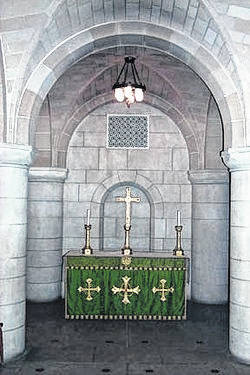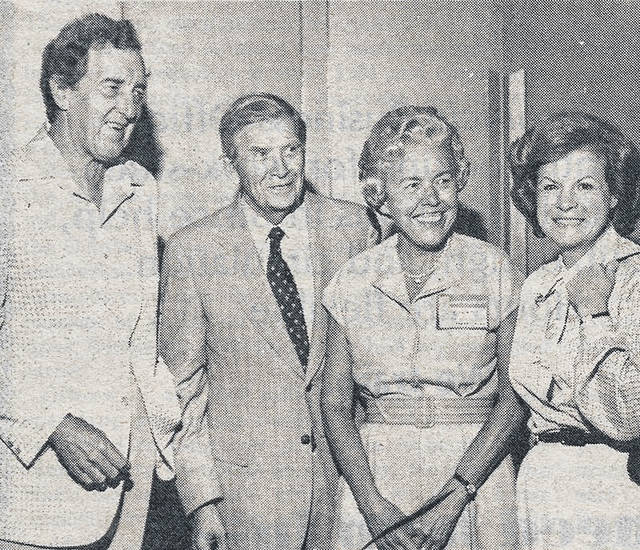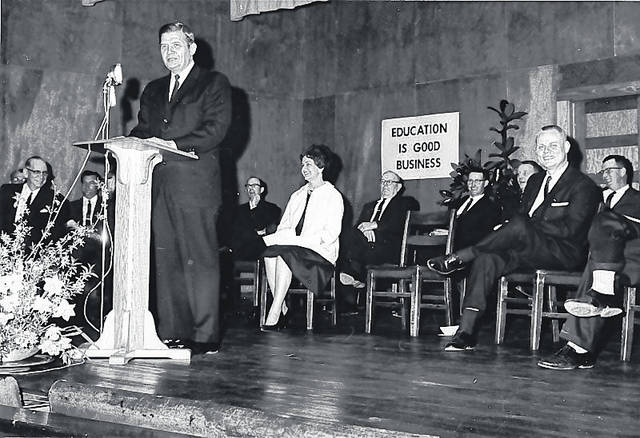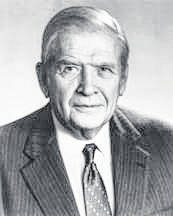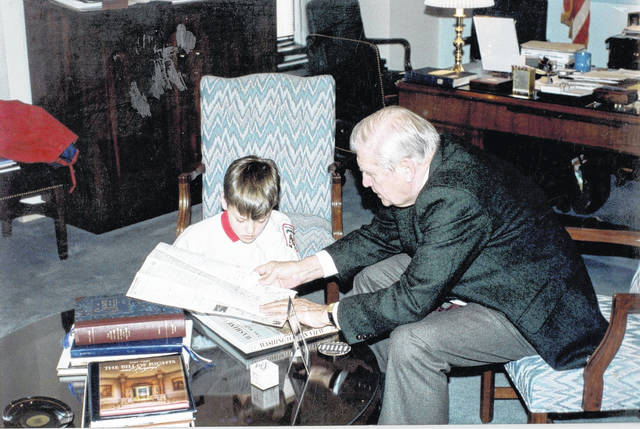Terry Sanford remembered by local historian, who
first met the soon-to-be governor as an 8-year-old
LAURINBURG — The late Sen. James Terry Sanford, who was the son of Elizabeth Terry (Martin) and Cecil Leroy Sanford, was born on Aug. 20, 1917, in Laurinburg. He was the second of five children.
Most already know of Sanford’s accomplishments and rise to the Governor’s Manskion in Raleigh. But there are some insights most may not be aware of about Sanford.
Local historian Beacham McDougald recalls Sanford as being a genuine, hard-working and dedicated.
“In the spring of 1960, I was 8 years old and in the third grade,” said McDougald. “This is when I was first introduced to politics. My next-door neighbor, Mary Whaley Phillips Hunt, the mother of one of my childhood friends, asked us to help her friend, Terry Sanford, win the election to become North Carolina’s next governor.”
McDougald said while at that age he didn’t even know North Carolina had a governor, the task seemed like something “grownup” to try.
“I searched newspapers for stories and photos of Terry, cut them out, and made a campaign poster with them,” said McDougald.
On a spring Sunday after McDougald had completed his poster, he said he was approached by Sanford’s mother.
“She saw me at church and told me that she had heard about my poster, and she wanted to see it,” said McDougald. “That was when I learned that Terry Sanford was her son, so there would never be any doubt that Terry was a good man. Miss Betsy was a well-known school teacher and a Sunday school teacher at the Methodist church.
“Since Miss Betsy, always called him ‘Terry,’ well, that’s what I always called him. Adults sometimes chuckled when I did, and I never understood it,” McDougald added.
One of the polling places at the time was Central School, which was across the street from McDougald’s home.
“I placed my poster on a stake by our campaign table for the primary race, and surprisingly Terry came by and looked over the poster, politely thanking me for making it,” McDougald said. “Being young and naive, I asked Terry if he would write me a note and let me know if he won. Surprisingly, he remembered and I still have the letter.”
McDougald was 9 years old when Sanford won the election in November 1960.
“After he became governor he sent me an invitation to visit with him at the Governor’s mansion in Raleigh,” said McDougald. “I was in the fifth grade in April of 1962 before my mother could arrange a spring Saturday to visit him in Raleigh with three of my friends.”
Sanford took the boys on a museum tour in Raleigh, a tour of the Governor’s Mansion and a dinner of country-style steak during their visit.
“In 1972 I was a student at East Carolina University when Terry decided to take a break from being president at Duke University and run for president of the United States of America,” said McDougald. “His support for equality and public education were attractions, and I became active in an on-campus group.”
One weekend during a trip back to Laurinburg during Sanford’s campaign, McDougald received a phone call asking him to drive Sanford around to visit with some of his old friends.
“My car at the time was a used 1963 Chevrolet Impala that cost $400 when I bought it,” said McDougald. “It was a perfect representation of Terry’s humble beginnings.”
The duo met at Bill Adams’ Esso, and their first stop was at the home of an old friend in East Laurinburg, where they sat on the porch and reminisced.
“Two other stops followed at homes that Saturday morning as he recalled places in his childhood neighborhood, growing up on Caledonia Road near the railroad tracks,” said McDougald.
The 1972 campaign came to a close against George McGovern and Hubert Humphrey.
“Terry even lost the North Carolina primary to Alabama Gov. George Wallace, who was, ironically, a distant cousin of mine,” said McDougald. “The primary defined that the conflict in Vietnam and opposition to racial integration were more important issues in 1972 than public education and ending the conflict in Vietnam.”
After Sanford’s loss, he returned to Duke University.
“Fast-forward to 1986, Terry decided to run for a US Senate seat from North Carolina and he won,” said McDougald. “My wife, Lynn, and I took a flight from Raleigh early on Dec. 10, 1986, to attend his swearing by the Honorable ‘Dick’ Phillips on the steps of the US Capitol and later attend a quick reception afterward before catching a flight back to RDU.”
Two years later, McDougald and his wife visited Washington during a spring break with their newly adopted 5-year-old twins, Michael and Marie.
“Terry arranged for us to travel on the Senate subway system and hosted us for about 30 minutes in his office,” said McDougald. “Ironically, it was another bond we shared as their two children were also adopted.
“We were proud of Terry, and of the warm friendships and small-town values that we shared,” McDougald added. “A humble yet very intelligent native of Laurinburg had already made and would later make more very positive changes for our state and nation.”
According to McDougald, Sanford was politically perceived to have many faults in the minds of some.
“He was too progressive, he strongly backed the ideas of equality for everyone and was a champion of strong public education. He even established the first community colleges and technical colleges in North Carolina,” said McDougald. “In the early 1960’s North Carolina had a 3% sales tax upon everything but groceries. To pay for the needed improvements in public education, Terry persuaded the North Carolina Legislature to pass a 3% sales tax upon groceries to pay for educational improvements, thus earning him the name of ‘Taxing Terry.
“In reality, North Carolina’s system of public education became a model for our nation,” added McDougald, “thanks to the son of a public school teacher in Laurinburg.”
When one major publication named the 10 most influential Governors in the United States for the 20th century, McDougald said, there was no surprise to see Sanford listed in that small, amazing group.
“Terry was genuine,” said McDougald. “He cared for and remembered the names of people, he found a positive solution for just about any issue and in the few mistakes that he made as Governor, President of Duke University, or US Senator; he owned them and accepted full responsibility.
“After all,” McDougald added, “his mother, Miss Betsy, raised all of her children to be that way.”
Sanford’s early years
Sanford’s father ran a hardware store and his mother was a teacher. The Sanfords were described as a middle-class family during his childhood.
During the Great Depression, his father’s hardware store was forced to close and he struggled to find steady work and performed temporary jobs while Sanford’s mother returned to teaching full time.
Despite the family’s economic troubles, the Sanfords never went hungry and Sanford later reflected that he never thought of his family as poor.
In the summer of 1930, Sanford became a member of Laurinburg’s new Boy Scouts of America Troop 20. In July 1932, he became an Eagle Scout.
Sanford was quoted later saying, “What I learned in Scouts sustained me all my life; it helped me make decisions about what was best.”
Sanford, along with his brother worked multiple jobs to make money while they were younger, which included raising chickens and pigs, selling vegetables, picking cotton, planting tobacco and delivering newspapers.”
His final resting place
Sanford passed away at his home at the age of 80 after a battle with cancer on April 18, 1998.
Funeral services were held four days later at Duke Chapel. In attendance were 17 U.S. senators, four former governors, 100 members of the General Assembly and the North Carolina Council of State.
His final resting place is the Chapel’s crypt in Durham.
JJ Melton can be reached at jmelton@laurinburgexch.wpenginepowered.com.

